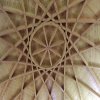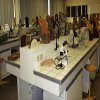Wood school
11 February 2010The Ecole Supérieure du Bois (ESB) was established in Paris in 1934 as a result of financial support from the wood products sector and significant lobbying of the Ministries of Agriculture and Higher Education.
It moved to Nantes in 1993 into purpose-built premises with a state-of-the-art tiered 220-seat lecture theatre as well as substantial classroom, laboratory and workshop facilities.
The ceiling of the wooden-clad lecture theatre is a cantilevered wooden construction assembled entirely with the use of bolts and no adhesive – a design which befits perfectly a wood-centred institution such as this.
Development plans for the site include a 2,000m2 extension for two more large lecture theatres, a canteen, offices, additional research laboratory and an extension to the workshop. The whole extension has been the subject of a design competition.
There are separate laboratories for teaching chemistry, mechanics and wood anatomy, with the latter being equipped with a wide and fascinating array of wood samples from around the world.
There is also a ‘finishes’ laboratory equipped with a spray booth and curing tunnel.
“Most wood products have some form of finish applied to them and it is often the finish that fails and this is why our students must understand finishes, their application and testing,pointed out Englishman Dr Mark Irle, deputy director of ESB, who formerly ran the Forest Products Research Centre at Buckinghamshire New University in High Wycombe in England. Dr Irle is also familiar to readers of WBPI as the author of our regular column Technically Speaking.
The mechanics laboratory has a test rig to determine modulus of bending, elasticity and so on and is also equipped with an artificial weathering system for testing wood components to French national standards. It also has two QUV accelerated weathering test chambers for international standards of artificially weathering finishes.
With the great emphasis placed on volatile organic compound (VOC) emissions from wood and wood products these days, you would expect ESB to be well-equipped to measure such chemicals – and it is.
The analytical laboratory conducts tests to European standard EN717-2 by the gas analysis method, using equipment supplied by specialist company Timber Test of New Zealand. The same company supplied a one cubic metre chamber for testing formaldehyde emissions to EN717-1.
The laboratory is also equipped to measure emissions with the flask method, to EN717-3, and has a set of Japanese desiccator jars.
“Temperature control is crucial to the desiccator test, hence we have bought a new 1.5m3 conditioning chamber,explained Dr Irle.
The laboratory uses the European acetyl acetone method and Jenway scanning spectrophotometer to obtain a precise measure of the concentration of formaldehyde captured by the various test methods.
Outside in the yard of the university are modules representing housing units built to different insulation standards where different types of cladding and finishes are tested in an outdoor environment.
The university premises are organized into three main zones: One part is ‘public’ and serves as a venue for industry meetings and conferences; another is for teaching, with classrooms, laboratories and workshops; the third part is for administrative functions.
The ESB is a private university so students, who come from around the world as well as France, pay for their own tuition.
The large workshop (soon to be expanded even further) enables the construction of quite large projects and at the time of our visit, students were building a podium, or display base, for an exhibition to be held at the prestigious Pompidou Centre in Paris. This offers the students a ‘real-life’ project on which to hone their skills, while at the same time providing the university with some pro-motional opportunities, raising awareness of what the institution can offer.
The ESB offers a range of qualifications from the more practically-biased BTS qualifications right up to a Masters degree.
“The Ecole Supérieure du Bois wood specialist is first and foremost a professional with a practical background, with high transversal scientific expertise and well-defined technical skills necessary to fit into a company,says the ESB brochure. “He – or she – is able to match the new requirements of an engineer’s position in terms of ability to complete projects, to use tools to understand the complexity of society and modern companies.
He or she is particularly open to the world”.
The brochure claims that 88% of the graduates find a job within two months of ending their studies and points out that the French wood based economy provides 550,000 jobs with a turnover of € 27.5bn. Those figures may not of course hold true in the present economic climate but give an indication of the importance of the wood industry to France’s national economy.
Commencing in September 2010, ESB will be offering a post-masters degree entitled Bioresources Composites: Innovation and eco-design.
This will be a programme “designed for engineers and high-level professionals who wish to enhance their capabilities in innovation and eco-design within the domain of wood and polymer based composites,says the university.
The Ecole Supérieure du Bois, through its research, is adding to the global fund of knowledge about the wood and wood products sector and two of its young students gave their first presentations of their scientific work for their doctorate degrees at the International Panel Products Symposium held in Nantes in mid-September.
Institutions such as the ESB in several countries are continually working to add to that fund of knowledge and to help the panel manufacturers (among other wood based industries) to run more efficiently, economically and to work within the regulatory limits set for emissions, as well as other environmental targets.

